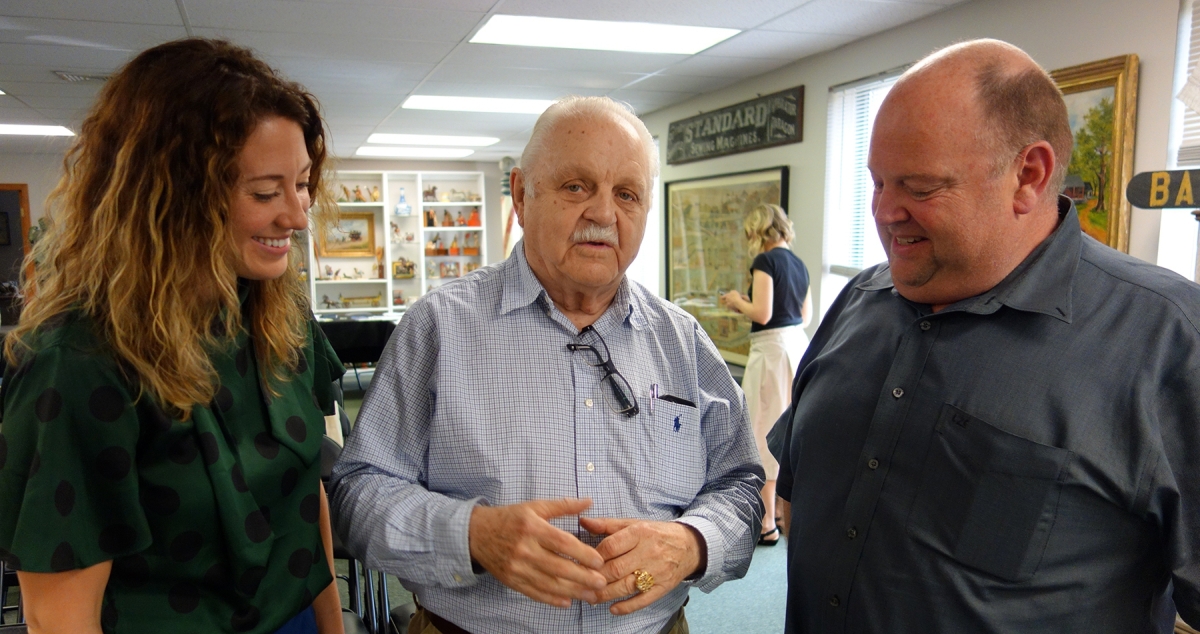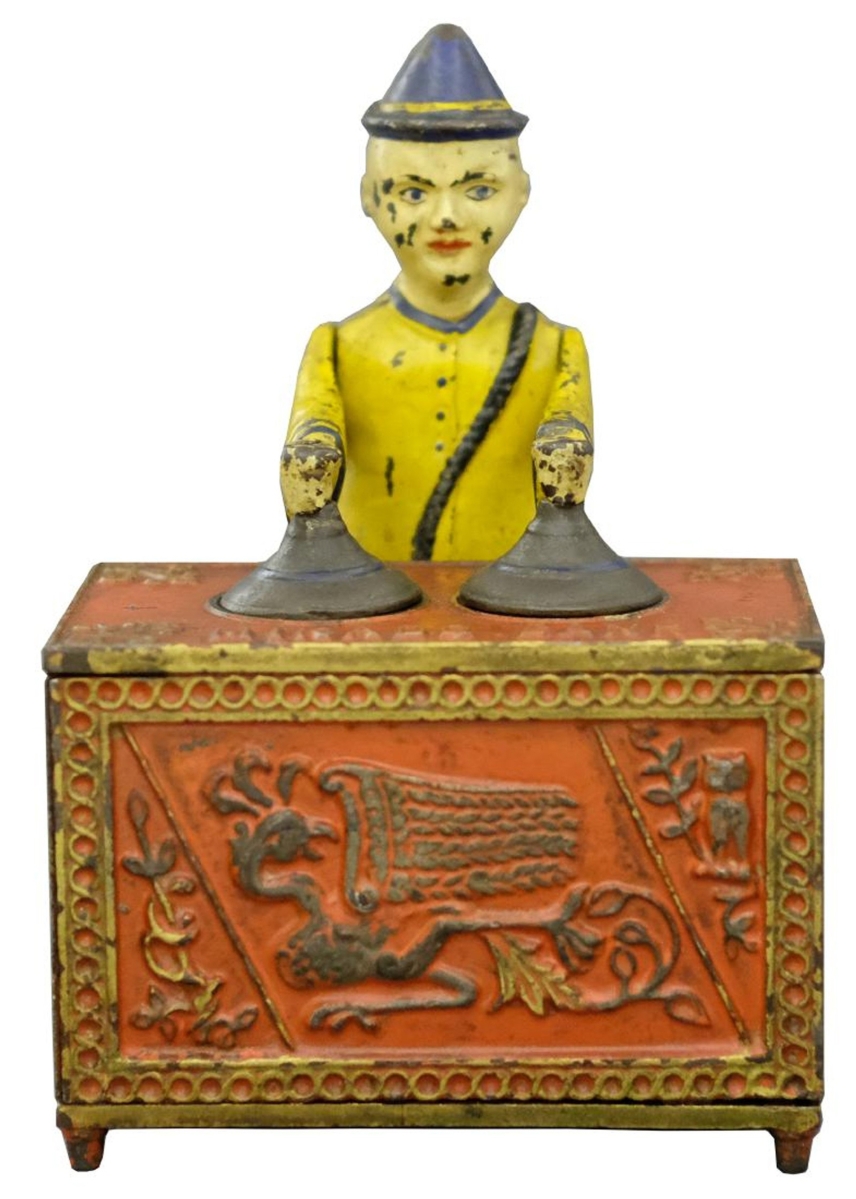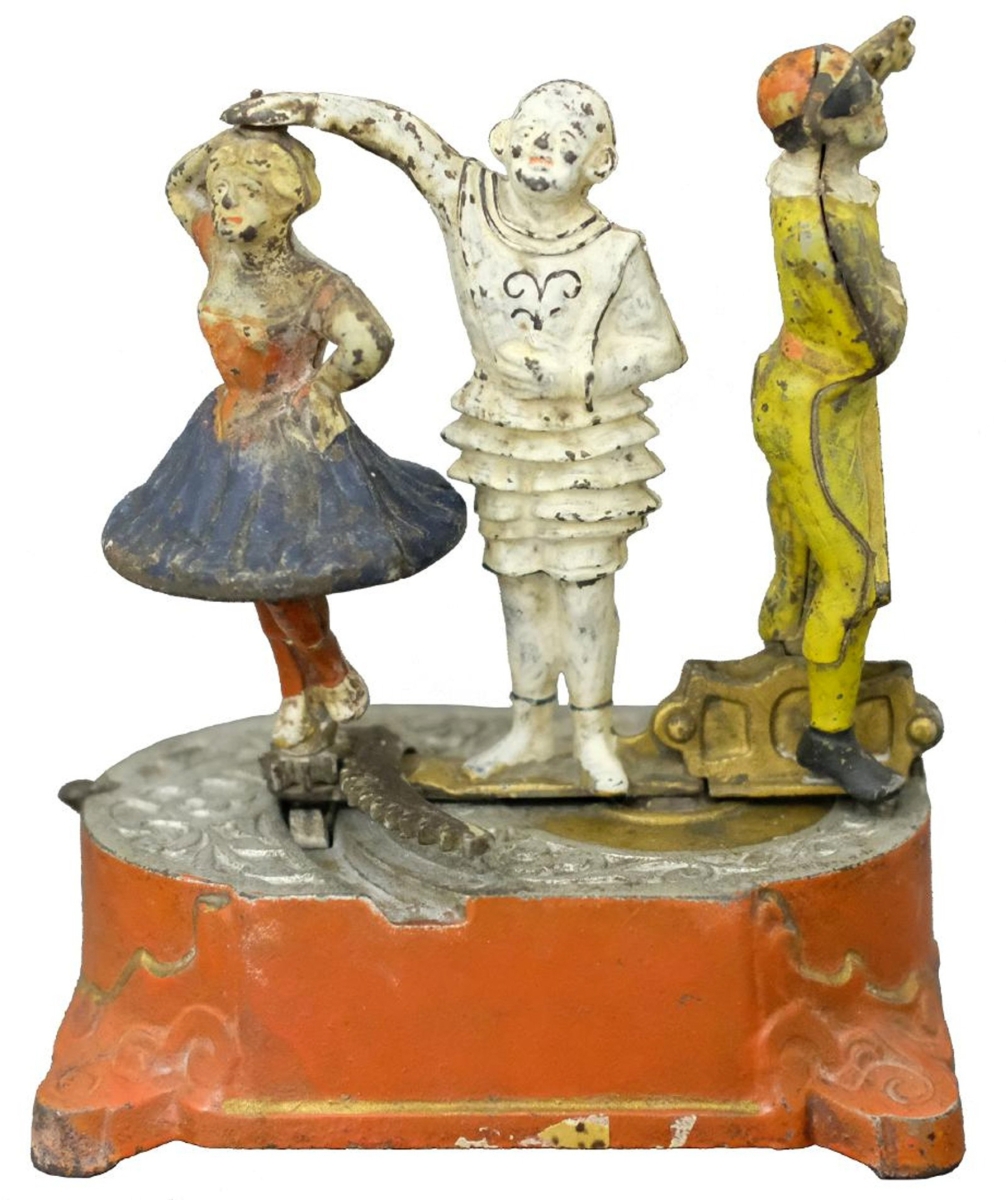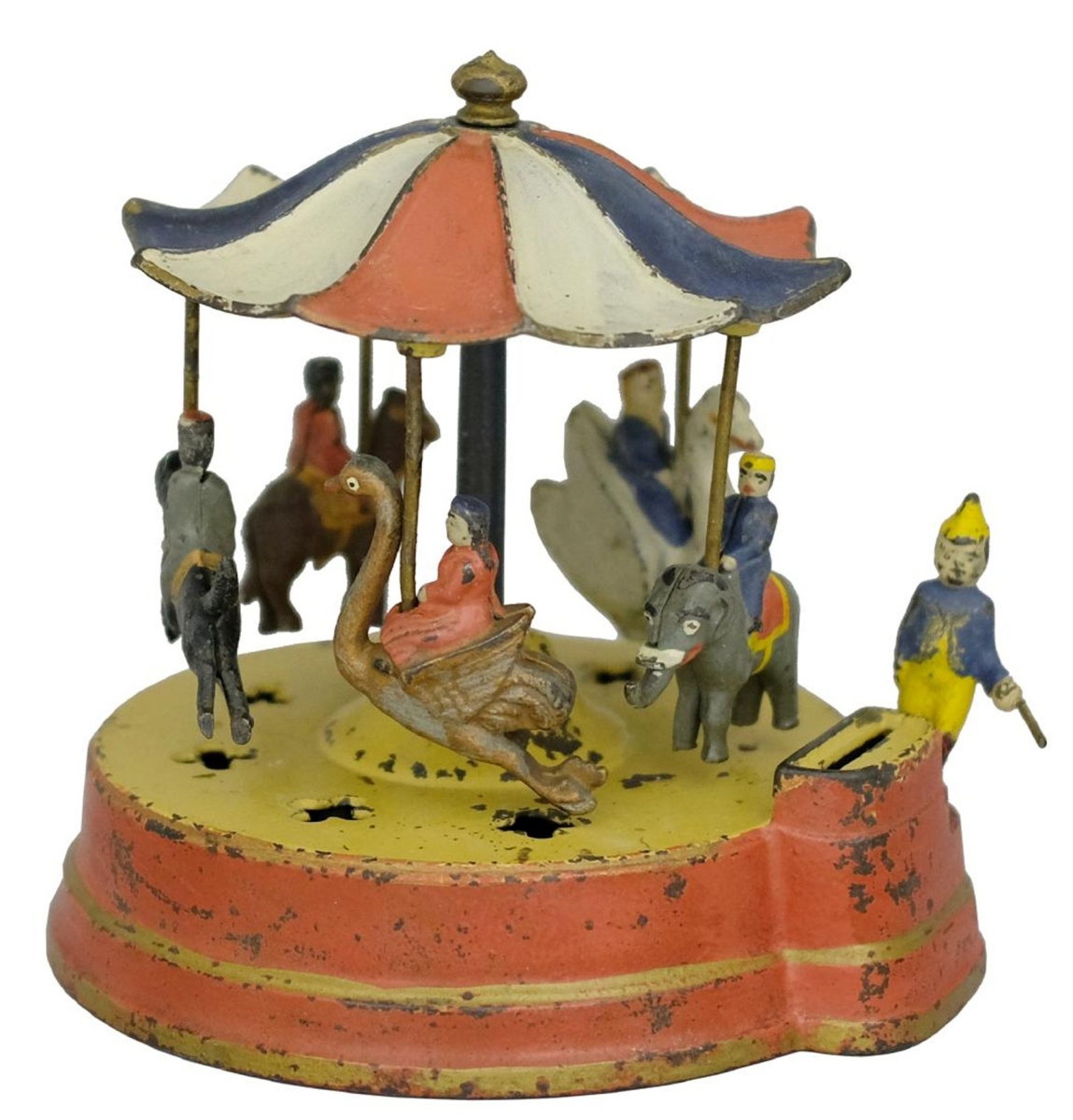
Bre Day, RSL’s senior auction specialist, and Ray Haradin, right, with Tom Sage before the start of the auction.
Review and Onsite Photos by R. Scudder Smith, Catalog Photos Courtesy RSL Auctions
WHITEHOUSE STATION N.J. – It was the early 1980s when Tom Sage spotted an ad in the Allentown newspaper announcing that a local auction out in western New Jersey was offering a Merry-Go-Round mechanical bank among a collection of large and small household objects. The word “mechanical” grabbed Tom’s attention, for this Merry-Go-Round bank was not the ordinary still bank that showed up frequently.
Without question, he went to the sale and came home with a mechanical bank that was in beautiful, pristine condition, a perfect start to the now famous Tom and Lori Sage Mechanical Bank Collection.
“I have had several auction houses seeking the collection, and when the time came to sell it, I called upon RSL,” Tom said prior to the start of the auction on Saturday, June 2, at 10 am. The auction ended before noon, when the last of 176 lots was hammered down by Richard Opfer, auctioneer, for a grand total of $1,766,088.
Following the sale of two popular banks, the leadoff lot of Squirrel and Tree Stump and Girl Skipping Rope (both pictured), Boy Robbing the Bird’s Nest, J&E Stevens Company, Cromwell, Conn., circa 1906, mint and bright, went over the $35,000 high estimate, selling for $37,200. This was followed by the Polychrome Artillery Bank with the rare Confederate Officer, again J&E Stevens Company, circa mid-1890s and in near mint and bright condition. The catalog notes that this bank, with a Donal Marky Collection provenance, is “probably the finest known specimen.” It sold for $30,000, which was $5,000 over the high estimate. All prices reported include the buyer’s premium.
One page of the catalog was devoted to six Jolly “N” figures, all dressed in red, including one with a top hat, another with wiggly ears, a small version, a Jolly “N” with pink lips and another with red lips. The top lot in this grouping was a Jolly “N” with a Boater Hat, the right sleeve with sergeant stripes, made by the Starkies Company in Burnley, England, circa 1930s. It is of aluminum, near mint and bright, and sold two times the high estimate for $1,440.

The Mikado Bank has already been featured in this paper, but it bears repeating as it was the top lot in the sale at $144,000. Made by the Kyser & Rex Company of Philadelphia, late 1880s, the provenance lists John Meyer Collection, and it is a pristine and bright example.
Lot 32, Initiating Bank-Second Degree, aka Goat, Frog and Old Man, was made by Mechanical Novelty Works, New Britain, Conn., circa 1880s. This was another bank with a Donal Markey provenance, pristine condition and sold over the $8,500 estimate for $10,200. A few lots later, the subject of this bank was a farmer who caused a “bad accident” while driving his crops to market because he was eating a juicy slice of watermelon instead of paying attention to the road in front of him. Named Bad Accident Bank, again by J&E Stevens Company, it sold for $14,400, just shy of the high estimate. The provenance listed Donal Markey, and the bank was in pristine condition and boxed.
Speaking of watermelons, lot 36, Boys Stealing Watermelons, by Kyser & Rex Co, Philadelphia, circa 1880s, sold just over the high estimate at $9,600. Once again, the provenance goes to Donal Markey for this near mint and bright bank. The always popular Zoo Bank by Kyser & Rex Co, circa 1800, pristine condition, went over estimate, bringing $2,400.
Selling for $27,600, as close to the high estimate as one can possibly get, was the Humpty Dumpty Bank by Shepard Hardware Company, Buffalo, N.Y., circa 1888. In near mint and crisp condition, with a Donal Markey provenance, this figure swallowed a coin from his hand, similar in action to the Jolly “N.”
Seven elephants were in the sale, taking up two pages in the catalog, including lot 71, Elephant with Three Stars, maker unknown, American, circa mid-1880s, in excellent condition, that sold below estimate at $360. Lot 74, Elephant with Locked Howdah, single tree stump on base, the bank created by Early Bank Collectors, American, circa 1940-50s, went for $2,760, above estimate. This bank was in mint plus and bright condition.
Two Chief Big Moon Banks were offered, in varied colors and both by J&E Stevens Company, circa 1899. The first, in a combination of shades of green, pristine plus, sold for $3,900, while the other example in scarce red and yellow base colors, pristine plus and bright, sold for $12,000, the low estimate.
J&E Stevens Company is well represented in frog-themed banks, including four examples of the Frog on Round Base. The first dating to the 1870s, pristine plus condition, had a red and yellow base and sold for $2,280, followed by the frog on a blue and red base, pristine condition, that brought $1,920. The third example had the frog sitting on a rare green and brown base, near mint, for $5,400, and the last frog, with a teal blue and burgundy base, pristine plus condition, jumped into second place with a bid of $4,500. Pictured on the same page was The Two Frogs Bank, also by J&E Stevens Company, near mint and luminous, that went for $5,000 over estimate, selling for $20,400.

Lot 85, the Clown, Harlequin and Columbine bank, made by J&E Stevens, Cromwell, Conn., circa 1890s, sold for $108,000, just under high estimate of $120,000. The catalog notes that “The Harlequin Bank is one of the most beautiful and complex cast iron toy bank ever produced. The bank presents us with three distinct theatrical personalities set upon a stage of glittering silver and gold.”
A popular Tammany Bank, black/brown coat version, by J&E Stevens Company, circa 1890s, mint and very bright with box, sold within estimate for $7,200. Again, the provenance listed Donal Markey. Lot 93, Reclining Chinaman Bank, again J&E Stevens Company, circa 1880s, sold for $21,000, near the top of the $22,500 estimate. This entertaining bank, pristine and bright, has a reclining man on a log who invites the viewer to play a hand of poker with him.
J&E Stevens Company created the Owl Turns Head Bank in varied colors of the owl’s body, with three different versions offered. The first was brown, grey and white at $720; the second, the most popular, was the rare all-white example, selling for $1,440; followed by the yellow and brown owl at $1,200.
The Mammy and Child Bank made by Kyser & Rex Co, Philadelphia, dated mid-1880s is a genuine classic in every way. The Mammy was produced in multiple dress colors that include tan, yellow, mauve, green, red and blue. This auction included the tan dress, the scarce color, excellent condition, that sold for $5,100, within easy reach of the low estimate. Selling for $15,600, within estimate, was Mammy in the green dress and in excellent bright colors. The third example had Mammy in the blue dress, pristine and luminous, for $20,400, within estimate, and the final example was Mammy in the rare mauve dress, pristine and bright, that sold for $15,600, also within estimate. It is noted in the catalog that many collectors adore this bank, and they attempt to acquire each and every dress color.
Two examples of Punch and Judy by Shepard Hardware Co, circa 1880s, included one with small letters, which went for $1,680, followed by the bank with medium letters, pristine and bright, for $3,900, within estimate. Shepard also produced the popular Picture Gallery, a circa 1888 example in excellent plus condition. This bank has a feature designed to teach the alphabet to small children, and it sold for $24,000, above estimate.
The Gallery was followed by lot 125, Bread Winners Bank, J&E Stevens Company, circa 1876, pristine condition, that sold for $42,000. Collectors have regarded the Bread Winners Bank as one of the most historically significant banks ever created. Considered one of the prettiest banks ever created is the Confectionary Bank by Kyser & Rex Co, circa 1881, in excellent plus and bright condition, went for $6,600, within estimate. This is one of a few banks that offer children a reward that encourages them to save money. Necco Wafers can be loaded into the bank on the back side, and when a penny is inserted in the slot and the lever is pushed forward, the shop lady will turn to fetch you a candy from her drawer.
The Horse Race Bank, flanged based, J&E Stevens Company, circa 1871, again has a Donal Markey provenance, a pristine and bright example and sold within estimate for $27,600. This bank was originally marked as the “Race Course Bank,” and this example is truly a magnificent specimen. It was followed by Calamity Bank, another J&E Stevens Company bank, circa 1905, pristine plus condition, that brought $33,600, within estimate. This bank portrays collegiate football as it was played at the beginning of the Twentieth Century. In this particular example, two defense tacklers from Harvard are taking down a running fullback from Yale.

Manufactured by Kyser & Rex Company of Philadelphia was the Merry-Go-Round bank circa 1888, pristine and bright, that sold for $84,000, just under the high estimate. The catalog notes that “It has absolutely everything going for it, with a color palette that is varied, bright and cheerful.” Very few examples of this bank have made it into modern times unbroken, but this example is completely original.
The last three pages of the catalog included a varied selection of lithographed tin banks, including Minstrel Bank with Verse at $450; Jolly Joe the Clown with Verse, $390; a scarce variation of Jolly Joe the Clown, $1,140; and the Crossed-legged Minstrel, Germany, circa 1910, excellent plus, brought $840. Just before offering lot 176, the end of the sale, auctioneer Rick Opfer commented, “I am selling this just before we break for shrimp sandwiches,” referring to the raw bar and barbecue RSL hosted the night before. With that, the bid of $1,080 took away the lithographed Saluting Sailor Bank, dating in the mid-1920s.
It appears from the frequent mention of Donal Markey that Tom and Donal spent many hours together, times that Tom treasured with his friend and always learning about banks and what banks are right for his ever-growing collection. In addition to steering banks to Tom and Lori, Donal let many of his banks move into the Sage Collection.
Was Tom happy when the auction ended? “I knew that some of the more ordinary banks would not do well, but the really rare banks and those with top-of-the-line surface performed very well,” Tom said. He added that he still has a number of mechanical banks at home, “but I let the top of the collection go, and when I had multiple examples of a particular bank, with a few exceptions, I sold just one, not wanting to flood the market,” he said.
It should be noted that Tom Sage is not just a bank collector. In the 1960s, he was deep into American and European trains, and if you happen on his booth at an antiques show, you found a fine and varied selection of rare toys.
You might say that Tom and Lori, with many interests, are as rare as the objects they collect.





















